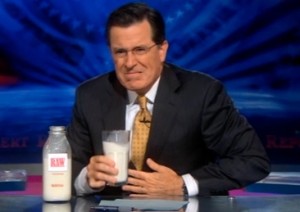I don’t care who does the regulating as long as the data is public, verifiable and producers are liable. There are benefits and faults with the many systems out there that could be largely remedied with public access to data and marketing of microbial food safety at retail.
 And I’m sure the raw milk producers promoting self-regulation would have no problem with genetically engineered foods, meat and restaurants being self-regulated.
And I’m sure the raw milk producers promoting self-regulation would have no problem with genetically engineered foods, meat and restaurants being self-regulated.
At least I’m consistent.
Deena Prichep of NPR’s The Salt reports that Mark McAfee, the CEO of Organic Pastures, California’s largest raw milk dairy has founded the Raw Milk Institute.
“People are searching for local raw milk,” McAfee explains. “But when they go to the farm, or they go to the store, they really don’t know what they’re getting.”
To create both accountability and transparency, McAfee worked with epidemiologists, biologists and other health professionals to create RAWMI’s standards. Instead of just focusing on the end results, like bacteria levels, they also worked up detailed protocols for the entire process — from taking the temperature of the dishwasher used to clean the milk bottles to the distance between the water well and manure pile.
The group is also looking at the risk specific to each farm, whether it’s a muddy slope with three cows in Oregon or a sunny California farm with a midsize herd.
When a farm completes its hazards analysis, planning and testing — and passes a site visit from RAWMI — it is listed on the institute’s website. Right now there are half a dozen farms listed, with 10 more in the midst of the process.
The first farm to be listed was Champoeg Creamery, a small dairy about 30 miles south of Portland, Ore. Owner Charlotte Smith is a fifth-generation farmer. But when she first started producing raw milk a few years ago, she discovered it was an entirely different animal.
“I could call the extension office, and get some help on what was going on with my vegetables, or what is this beetle eating my tomatoes,” says Smith. “But there’s no one that will help you with raw milk production.”
And with about 100 families buying her milk — and monitoring an E. coli outbreak at a neighboring farm that landed kids in the hospital — Smith was committed to getting it right. Because while Smith says raw milk may offer health benefits, she also acknowledges the very real dangers.
“You can bring home a chicken and sell the eggs, and feel pretty safe about it. But raw milk, coming out of a cow, and manure flying during milking time — it is a huge challenge, far different than any other farm animal we have.”
As someone looking for guidance, Smith was a bit surprised that national regulatory agencies wouldn’t lend their expertise to establishing safety criteria. To them, she says:
“Raw milk is here to stay, whether you want to admit it or not. So why not work together, come up with some very basic things, where if you’re going to produce and sell raw milk, you’re going to agree that you have met these standards. In my mind, it seems so easy.”
Robert Tauxe at the Centers for Disease Control and Prevention says that while the safety plans and regular testing advocated by RAWMI can certainly reduce the risk of bacterial contamination, they can’t offer any certainty that the particular gallon you grab from the shelf is truly safe.
“A cow can test negative today, and then get infected tomorrow,” notes Tauxe.
Tauxe is not unsympathetic to the reasons people seek out raw milk. “I understand the interest in having colonies of living bacteria in the food we eat,” he says. “The problem is when those living bacteria that are beneficial get mixed up with the living bacteria that cause disease.”
